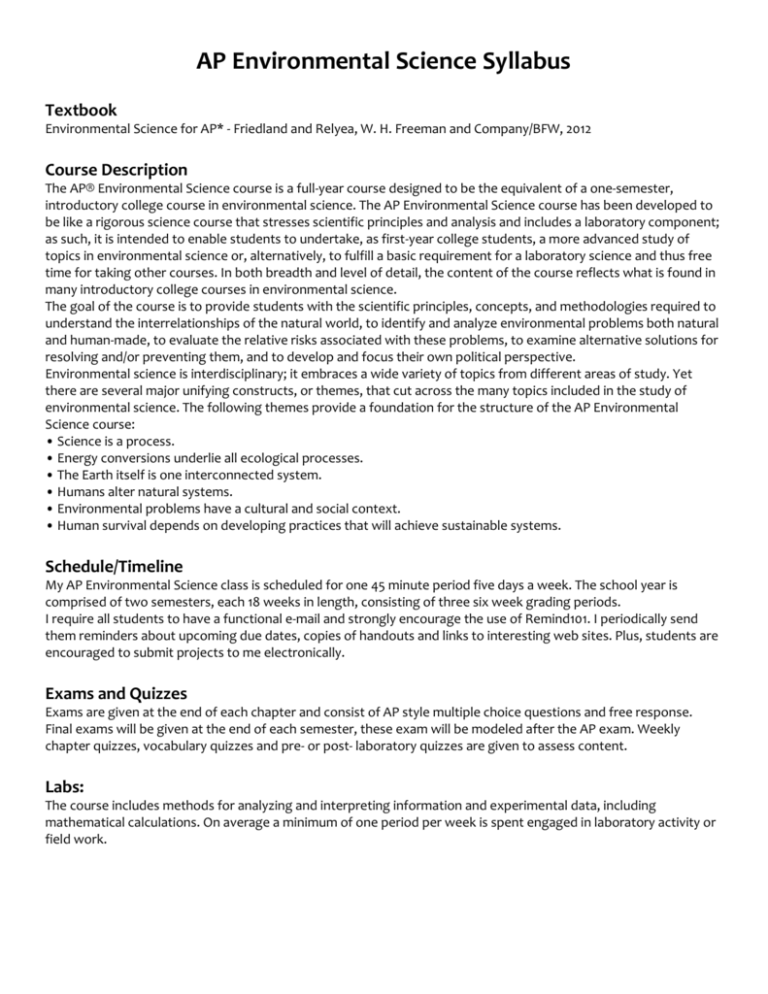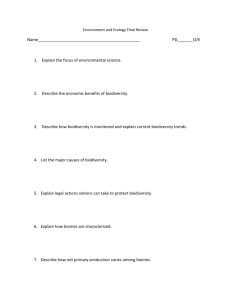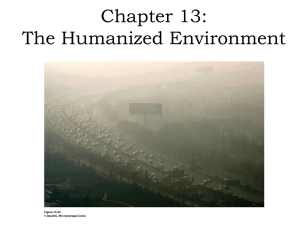APES Syllabus
advertisement

AP Environmental Science Syllabus Textbook Environmental Science for AP* - Friedland and Relyea, W. H. Freeman and Company/BFW, 2012 Course Description The AP® Environmental Science course is a full-year course designed to be the equivalent of a one-semester, introductory college course in environmental science. The AP Environmental Science course has been developed to be like a rigorous science course that stresses scientific principles and analysis and includes a laboratory component; as such, it is intended to enable students to undertake, as first-year college students, a more advanced study of topics in environmental science or, alternatively, to fulfill a basic requirement for a laboratory science and thus free time for taking other courses. In both breadth and level of detail, the content of the course reflects what is found in many introductory college courses in environmental science. The goal of the course is to provide students with the scientific principles, concepts, and methodologies required to understand the interrelationships of the natural world, to identify and analyze environmental problems both natural and human-made, to evaluate the relative risks associated with these problems, to examine alternative solutions for resolving and/or preventing them, and to develop and focus their own political perspective. Environmental science is interdisciplinary; it embraces a wide variety of topics from different areas of study. Yet there are several major unifying constructs, or themes, that cut across the many topics included in the study of environmental science. The following themes provide a foundation for the structure of the AP Environmental Science course: • Science is a process. • Energy conversions underlie all ecological processes. • The Earth itself is one interconnected system. • Humans alter natural systems. • Environmental problems have a cultural and social context. • Human survival depends on developing practices that will achieve sustainable systems. Schedule/Timeline My AP Environmental Science class is scheduled for one 45 minute period five days a week. The school year is comprised of two semesters, each 18 weeks in length, consisting of three six week grading periods. I require all students to have a functional e-mail and strongly encourage the use of Remind101. I periodically send them reminders about upcoming due dates, copies of handouts and links to interesting web sites. Plus, students are encouraged to submit projects to me electronically. Exams and Quizzes Exams are given at the end of each chapter and consist of AP style multiple choice questions and free response. Final exams will be given at the end of each semester, these exam will be modeled after the AP exam. Weekly chapter quizzes, vocabulary quizzes and pre- or post- laboratory quizzes are given to assess content. Labs: The course includes methods for analyzing and interpreting information and experimental data, including mathematical calculations. On average a minimum of one period per week is spent engaged in laboratory activity or field work. Classwork/Homework Assignments: ∙Students utilize the Friedland Relyea book and ancillary websites. ∙Students are taught methods for analyzing and interpreting mathematical calculations. Math concepts are reviewed with each appropriate unit to help the student solve environmental problems involving math. ∙Case Studies with unit topics are used to allow the student deeper breadth and understanding of the topic. Current Event Summary Each student will create a current events scrapbook throughout the course. The scrapbook will consist of news articles they have read pertaining to Environmental Science topics. Unit 1: Introduction to Environmental Science Chapter 1: Studying the State of our Earth Chapter 2: Environmental Systems Additional Resources: ∙ Video: The Lorax ∙ Ecological Footprint ∙Internet Activity: Top Environmental Stories Topics Discussed: The first unit of APES is an introduction to the concept and importance of environmental science. This unit explains the five environmental indicators that we use to judge the health of the planet. It reviews the scientific method and general science concepts. Unit 2: The Living World Chapter 3: Cycles and Ecology Chapter 4: Global Climate and Biomes Chapter 5: Evolution of Biodiversity Additional Resources ∙ Biogeochemical Cycle Project ∙ Owl Pellet Lab ∙ Top of the Food Chain by T.C. Boyle ∙ Climatogram analysis ∙Biodiversity Hotspots internet activity ∙ Layers of the Atmosphere ∙ Geological Timescale ∙Species Diversity Lab Topics Discussed: Chapter 3 is about the basics of environmental science. This chapter reviews the carbon, nitrogen, hydrologic and phosphorus cycles. It is important to commit to memory these cycles; they will come up many times throughout the year. Other important concepts include trophic pyramids, the formulas for photosynthesis and cellular respiration, food webs and food chains. Chapter 4 explains the Earth’s weather and climate. Important concepts are the layers of the Earth’s atmosphere, how temperature changes in each layer, the processes that affect climate, and how ocean currents influence weather and climate on Earth. The student will be familiar with the different types of biomes (both aquatic and terrestrial), and have a general understanding of each. Chapter 5 explains evolution and the processes that have create biodiversity on our planet. You need to understand the different levels of biodiversity (ecosystem, species and genetic) and the difference between species evenness and species richness. Also, know that populations can change into two genetically distinct populations by both natural means- such as a river- and also by human creations like cities. Unit 3: Populations Chapter 6: Populations and Community Ecology Chapter 7: The Human Population Additional Resources ∙Video: End of the Line ∙ Ecological Succession Internet Assignment ∙ Predation Lab ∙ Sample census lab: Mark-return-recapture method is used. ∙ Video: World in the Balance ∙ World Population Internet Lab ∙ Demographic Transition ∙ Power of the Pyramids lab Topics Discussed: Chapter 6 The principle objective of this chapter is to understand the dynamics behind population growth and the factors that drive growth. Chapter 7 The principle objective of this chapter is to understand human population growth. This chapter includes the social, economic and environmental factors that determine growth. The amount of resource consumption of a growing human population is also addressed. Unit 4: Earths Systems and Resources Chapter 8: Earth Systems Chapter 9: Water Resources Additional Resources: ∙ Virtual Earthquake www.sciencecourseware.org ∙ Video: How the Earth was made ∙ Soil Texture Lab ∙ National Geographic Xpeditions: www.nationalgeographic.com/xpeditions/lessons ∙ EcoBottle Lab ∙ Video: Tapped ∙ Video: Dirt ∙ Video: Blue Gold- world water wars Chapter 8 This chapter is all about earth science. It discusses Earth’s geologic cycle- the tectonic cycle, the rock cycle and the formation of soil. Chapter 9 The main objectives of this chapter are to identify and describe water resources and to understand how humans are managing and using this valuable resource. Unit 5: Land use Chapter 10: Land, Public and Private Chapter 11: Feeding the World Additional Resources: ∙ The Tragedy of the Commons by Garrett Hardin ∙ Tragedy of the Commons Lab ∙ Sustainable City Lab ∙ Video: Food Inc. ∙ Video: King Corn ∙ Hunger Lab ∙ Integrated Pest Management Project ∙ Article: Hallowed Ground - Nothing is Ever Sacred: The future of our national parks ∙ National Park Research Project Chapter 10 The key concepts of this chapter are the tragedy of the commons, public land management, and urban development. Chapter 11 this chapter focuses on the growing human population and the amount of food needed to sustain it. The objectives of this chapter are to understand hunger and malnutrition, agriculture, and the environmental impacts of different farming techniques. Unit 6: Energy Resources and Consumption Chapter 12: Non-renewable Energy Resources Chapter 13: Achieving Energy Sustainability Additional Resources: ∙ Video: Gaslands ∙ Coal Investigation Lab ∙ Video: Who killed the Electric Car? ∙ Solar Energy Lab ∙ Alternative Transportation Fuels Lab ∙ Home Energy Audit- Electricity Use Chapter 12: The major objectives of this chapter are to learn how energy is used, what nonrenewable resources are available and their uses and consequences, and how to calculate projections for future supplies of these resources. Chapter 13: The main objectives of this chapter are to understand what renewable energy is and to be able to explain the advantages and disadvantages of each type of energy. Unit 7: Pollution Chapter 14: Water Pollution Chapter 15: Air Pollution and Stratospheric Ozone Depletion Chapter 16: Waste Generation and Waste Disposal Chapter 17: Human Health and Environmental Risks Additional Resources: ∙ Video: Erin Brockovich ∙ Waste and Its Effect on Atmospheric Carbon Dioxide Lab ∙ Ozone Sampling Lab ∙ Smog City Internet Activity ∙ Video: Modern Marvels: Trash ∙ Garbology Activity: What’s in Our Waste Lab ∙ Video: Silkwood ∙ Hazardous Substance Home Audit ∙ Lethal Dose 50% Lab with Brine Shrimp Lab Chapter 14 This chapter explores the different substances that can pollute our water as well as the ways in which we clean water. Chapter 15 The main objective of this chapter is to understand the major indoor and outdoor air pollutants, smog and ozone depletion. The chapter explains where pollutants come from, approaches to pollution control and prevention, and the hazards created by air pollution. Chapter 16 The key objective of this chapter is to understand what constitutes waste and how we deal with the problems associated with it. Reduce, reuse and recycle are discussed in terms of solid waste. Chapter 17 The main objective of this chapter is to understand human health risks, infectious diseases, toxic chemicals and risk analysis. Unit 8: Global Change and Sustainable Future Chapter 18: Conservation of Biodiversity Chapter 19: Global Change Chapter 20: Sustainability, Economics and Equity Additional Resources: ∙ Video: Cane Toads ∙ Video: The Cove ∙ Invasive Species ‘Wanted’ Poster Lab ∙ Endangered Species Project ∙ Video: Dimming the Sun ∙ Climate Change lab ∙ Scarcity Lab Chapter 18 This chapter addresses biodiversity with a focus on conservation. It also looks at causes of declining biodiversity and the laws created in order to protect species. Chapter 19 The principle objectives of this chapter are to understand the concepts of global change, global climate change, and global warming. Students should have a firm grasp on the ways human actions affect global change and the impact of these actions on the environment. Chapter 20 The principle objectives of this chapter are to understand the effect economic activity has on the environment and on human well-being. The laws designed to protect the environment and human beings are discussed. The chapter also discusses the connections between economic costs and environmental protection together with social ramification.





